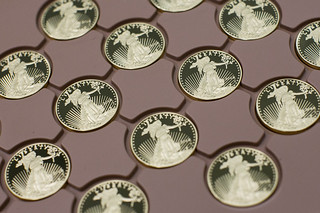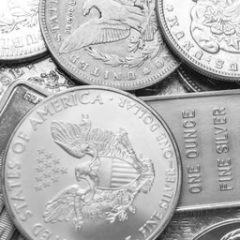Buyer beware when considering Gold IRA options.
This Wall Street Journal article hit the web last Sunday night about the time I was publishing last week’s issue. I decided not to include it, but it’s worth discussing, so here it is now. -Editor
 The U.S. Mint makes a pretty penny selling gold and silver coins. But there are two sides to the deal, which some investors are calling highway robbery.
The U.S. Mint makes a pretty penny selling gold and silver coins. But there are two sides to the deal, which some investors are calling highway robbery.
After years of making pennies and nickels that cost more to produce than they are worth, the Treasury Department is making a mint off a line of pricey American Eagle coins in what is known as proof condition—sheathed in plastic and never touched by human hands. Last year, sales totaled $112 million.
The government currently is selling the gold-coin proofs at a 25% markup over per-ounce gold prices, a premium that can run as high as $360 per coin. The silver coins carry a more than 200% premium over market silver prices.
That might be well worth it for coin collectors and hoarders—or for stashing in a post-apocalypse bunker along with the guns and freeze-dried macaroni. But some unhappy investors have deposited them into retirement accounts, where the shiny gold and silver coins have performed like lead sinkers.
Marvin E. Johnson, 61, of Kanawha, Iowa, said American Bullion Inc. sold him 930 American Eagle silver proof coins for his retirement account. He paid the equivalent of nearly 2 1/2 times the market price of silver. Then he sued when he saw his investment drop like a rock.
“He bought them at a premium where I don’t think he’d ever make a profit,” said Thomas Reavely, Mr. Johnson’s lawyer and coin collector.
Mr. Johnson and American Bullion later settled the coin dispute confidentially. Orkan Ozkan, American Bullion’s chief executive, said it wasn’t the company’s fault. Mr. Johnson, he said, paid the going rate: “We buy it high, mark it up and sell it high.”
Then he pointed a finger at the government. “Maybe you should ask that question of the Mint: Why are you charging so much for these coins?” he said.
The U.S. Mint does operate a bit like a coin dealer. Salespeople answer phones. An online store, with a pop-up chat window, adorns the website. Customers can sign up to have annual proof sets charged to their credit cards.
Mint profits on gold Eagle proofs hit nearly 18% last year. Net profits on the Silver Eagle proofs were even better, reaching about 41% last year.
The Mint transfers its profits to the Treasury’s General Fund. “We are not in it to make money,” said Kristie McNally, the Mint’s chief financial officer.
Mint officials said they pitch proof coinage as collector’s items, not investments. But Congress kept the door open to putting the coins into retirement account investments a few years after banning other collectible items in 1981.
Lawmakers allowed American Eagle proofs as an exception to the rule, making them a favorite for coin dealers pitching a “Gold IRA” to retirees.
The American Eagle proof, a double-struck coin, has been described as the most beautiful coin ever made. Plus, “you get a certificate” and “a little leather box,” said Rick Boss of Ohio, a proof-coin collector and retired AT&T engineer. “You’re getting a piece of history.”
Nonetheless, Jeffrey Christian, a precious-metals investment adviser, said he steers his clients away: “It’s sort of like buying a car and driving it off the parking lot. It will have an immediate depreciation.”
Educate me, readers – we don’t ordinarily cover topics such as pricing and investment. Is it really only the Proofs that can be placed in IRAs? Those are collector coins, not bullion pieces, as the article states – but wasn’t the idea to allow people to invest in bullion? Now, one can buy gold-mining stocks and other securities that rise and fall with the price of precious metals, but nothing beats having the stuff in your hands. And it’s great for playing Scrooge McDuck if you have more than a few to rub together.
Even the WSJ can get its numismatic facts wrong. NOTE: when talking to reporters, spell out the word D-I-E. -Editor
Gold and silver proof coins sold by the U.S. Mint aren’t colored with a special dye. An earlier version of this article incorrectly stated a special dye was used.
And how can it be that the Mint’s sales of proof bullion coins amounted to only $112 million? These aren’t cheap coins and it doesn’t take many ounces of gold to blow past $112 million. -Editor
